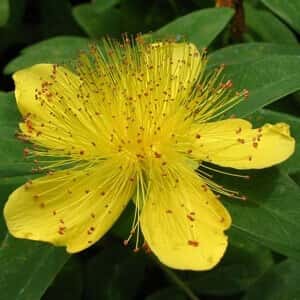
About twenty years ago, people who were reluctant to take prescription antidepressants were excited to learn that the herbal medicine St. John’s wort (Hypericum perforatum) could help alleviate mild to moderate depression (International Journal of Clinical Pharmacology and Therapeutics, March 1999). Some scientists became concerned, however, about an under-appreciated side effect of St. John’s wort. Some of the compounds found in this plant can trigger photosensitivity. This could damage eyes or skin when they are exposed to sunlight.
Is Sensitivity to Sunburn a Side Effect of St. John’s Wort?
Q. St. John’s wort has certainly been effective for treating my depression. However, I am extremely susceptible to sunburn, even when the temperature is not particularly high. I have to be very careful about protecting my skin when I go outside.
A. St. John’s wort has established antidepressant activity (International Journal of Molecular Sciences, March 2023). People who wish to use this herbal medicine should check with their physician or pharmacist to ensure that it will not interact badly with any conventional medications they are taking.
Pharmacologists think that hypericin is the most active constituent in this botanical medicine. It is known to be a powerful photosensitizer, which explains why pale-skinned people need to protect themselves from sunburn when they are taking St. John’s wort (Pharmaceutical Biology, July 2014).
We urge you to protect your eyes as well. This herbal product may damage eyes, particularly cells in the retina, when they are exposed to light (Photochemistry and Photobiology, May-June, 2007). As a result, people taking St. John’s wort might be more vulnerable to macular degeneration or even cataracts.
Is Hypersensitivity to Light a Side Effect of St. John’s Wort?
Q. I have taken several prescribed antidepressants over the years, but was not on any when I was offered a cup of St. John’s wort tea. It elevated my mood surprisingly well. I began drinking the tea intermittently and eventually added St. John’s wort tablets to my daily supplement regimen.
Within six months, I began to develop increasingly severe eye problems–hypersensitivity to light, blurriness, tearing and extreme dryness at night. The problems became worse and worse. I didn’t make the connection to St. John’s wort.
After searching the web, I found data linking St. John’s wort to vision damage. I stopped taking the supplement immediately.
To my relief, my eyes are slowly recovering. I want to warn others about the danger that St. John’s wort could damage eyes.
A. One of the active ingredients in St. John’s wort (Hypericum perforatum) is hypericin. This compound can damage both the lens and retina when the eye is exposed to light (Photochemistry and Photobiology, Nov-Dec, 2012). Even wearing sunglasses is not necessarily protective. Thanks for the reminder of this side effect.
Other Readers Report Photosensitivity as a Side Effect of St. John’s Wort:
We have heard from a few other people who have had similar experiences. Here are a few such stories:
St. John’s Wort Helped with Moderate Depression:
Q. I used St. John’s wort (SJW) tincture daily for moderate depression for several years when I lived in Minnesota. It was especially helpful with Seasonal Affective Disorder (SAD).
Photosensitivity didn’t bother me right away, but I eventually reached a point where light felt too bright to my eyes and I had to stop taking the herb. I concluded that the photosensitivity side effect of St. John’s wort is cumulative, increasing with duration of use.
I personally think that SJW is most helpful when used in northern climates with many overcast days in the winter. So it could be useful during short gloomy days in a place with long winters, like the UK. I would not recommend taking it in a place with long hot summers. Am I correct about this?
Pros and Cons of SJW:
A. The use of the herb St. John’s wort remains quite controversial.
A meta-analysis involving 27 clinical trials and over 3,000 patients (Journal of Affective Disorders, March 1, 2017) concluded that
“For patients with mild-to-moderate depression, St John’s wort has comparable efficacy and safety when compared to SSRIs.”
The authors note, however, that the studies were relatively short and the
“Evidence on the long-term efficacy and safety of St. John’s wort is limited…”
Research suggests that this herb can make the retina extremely sensitive to light and even damage eyes. This side effect of St. John’s wort could lead to the problem you experienced. St. John’s wort can also interact with many other medicines to reduce their effectiveness. Given such downsides, we would discourage the use of this botanical medicine for depression.
St. John’s Wort for Seasonal Depression:
Q. I have been taking St. John’s wort every day for over a year. I started taking it to combat depression (Seasonal Affective Disorder or SAD) that troubles me in the gloomy winter months.
I’ve noticed in the last few weeks my eyes are bloodshot red when in fluorescent lighting. I also suffered eye pain. My eye pupils are constricted to tiny pinholes.
I’m hoping when I visit my doctor I will find I haven’t damaged my eyes for life. I really could use an alternative to treat the depression.
A. We trust you have already stopped taking the herb. One of the active ingredients in St. John’s wort is hypericin. Although this compound may be partly responsible for the antidepressant activity of this herb, it can also damage a protein in the lens of the eye when it is exposed to light (Free Radical Biology & Medicine, July, 2013).
The investigators conclude that
“even by wearing UV-blocking sunglasses, routine users of St. John’s wort cannot adequately shield their lenses from hypericin-mediated photosensitized damage.”
Other Approaches to Seasonal Affective Disorder:
St. John’s wort can also interact with a number of pharmaceuticals (Expert Opinion on Drug Metabolism & Toxicology, Oct. 2017). Consequently, anyone who wishes to take this herb should discuss the plan with a health care professional to find out whether they will put themselves at risk for a dangerous drug-herb interaction.
St. John’s wort is not your only option for treating SAD. You may want to consider exercise, fish oil or light therapy. Of course, you would use light exposure only after the herb is out of your system so it wouldn’t damage eyes. For more information on the pros and cons of St. John’s wort and alternative approaches to treating winter doldrums, you may wish to read our online resource, eGuide to Dealing with Depression.
Consider Saffron:
If you wish to try a different botanical medicine, you might consider saffron. Research demonstrates that it works better than placebo to alleviate mild to moderate depression (Planta Medica, Jan. 2019). Although there has been little research on side effects of saffron, serious adverse events appear to be rare (Neuropsychiatric Disease and Treatment, May 21, 2018).
Citations
- Josey ES & Tackett RL, " St. John's wort: a new alternative for depression?" International Journal of Clinical Pharmacology and Therapeutics, March 1999.
- Dobrek L & Głowacka K, "Depression and Its phytopharmacotherapy-A narrative review." International Journal of Molecular Sciences, March 2023. DOI: 10.3390/ijms24054772
- Marrelli M et al, "Hypericum perforatum: Influences of the habitat on chemical composition, photo-induced cytotoxicity, and antiradical activity." Pharmaceutical Biology, July 2014. DOI: 10.3109/13880209.2013.872675
- Wielgus AR et al, "Phototoxicity in human retinal pigment epithelial cells promoted by hypericin, a component of St. John's wort." Photochemistry and Photobiology, May-June, 2007. DOI: 10.1562/2006-08-09-RA-1001
- Wielgus AR & Roberts JE, "Retinal photodamage by endogenous and xenobiotic agents." Photochemistry and Photobiology, Nov-Dec, 2012. DOI: 10.1111/j.1751-1097.2012.01174.x
- Ng QX et al, "Clinical use of Hypericum perforatum (St John's wort) in depression: A meta-analysis." Journal of Affective Disorders, March 1, 2017. DOI: 10.1016/j.jad.2016.12.048
- Ehrenshaft M et al, "Hypericin-mediated photooxidative damage of α-crystallin in human lens epithelial cells." Free Radical Biology & Medicine, July, 2013. DOI: 10.1016/j.freeradbiomed.2013.02.023
- Soleymani S et al, "Clinical risks of St John's Wort (Hypericum perforatum) co-administration." Expert Opinion on Drug Metabolism & Toxicology, Oct. 2017. DOI: 10.1080/17425255.2017.1378342
- Tóth B et al, "The Efficacy of Saffron in the Treatment of Mild to Moderate Depression: A Meta-analysis." Planta Medica, Jan. 2019. DOI: 10.1055/a-0660-9565
- Yang X et al, "Comparative efficacy and safety of Crocus sativus L. for treating mild to moderate major depressive disorder in adults: a meta-analysis of randomized controlled trials." Neuropsychiatric Disease and Treatment, May 21, 2018. DOI: 10.2147/NDT.S157550


